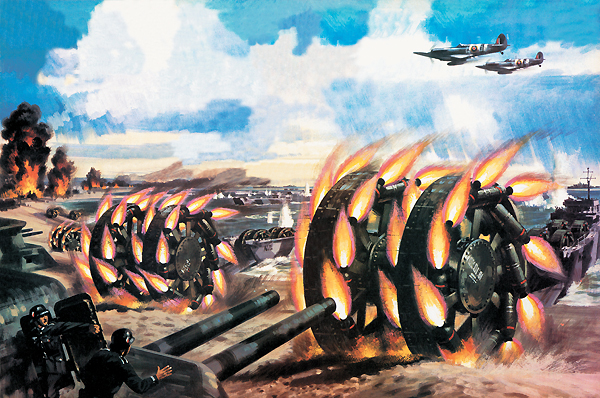Trojita
Rapid Response Threadmaker
https://en.wikipedia.org/wiki/Bat_bomb

I laughed and then realized this might have actually worked lol.

Bat bombs were an experimental World War II weapon developed by the United States. The bomb consisted of a bomb-shaped casing with over a thousand compartments, each containing a hibernating Mexican free-tailed bat with a small, timed incendiary bomb attached. Dropped from a bomber at dawn, the casings would deploy a parachute in mid-flight and open to release the bats, which would then roost in eaves and attics in a 20–40 mile radius. The incendiaries would start fires in inaccessible places in the largely wood and paper constructions of the Japanese cities that were the weapon's intended target.
The bat bomb was conceived by a Pennsylvania dentist named Lytle S. Adams, a friend of First Lady Eleanor Roosevelt. Adams submitted it to the White House in January 1942, where it was subsequently approved by President Roosevelt on the advice of Donald Griffin.
The United States decided to develop the bat bomb during World War II as four biological factors gave promise to this plan. First, bats occur in large numbers (for example, four caves in New Mexico are each occupied by several million bats). Second, bats can carry more than their own weight in flight (females carry their young—sometimes twins). Load-carrying tests were conducted in the dirigible hangar at Naval Air Station, Moffett Field, Sunnyvale, CA. Third, bats hibernate, and while dormant they do not require food or maintenance. Fourth, bats fly in darkness, then find secluded places (often in buildings) to hide during daylight.
By March 1943, a suitable species had been selected. The project was considered serious enough that Louis Fieser, the inventor of military napalm, designed 0.6 ounce (17 g) and one ounce (28 g) incendiary devices to be carried by the bats. A bat carrier similar to a bomb casing was designed that included 26 stacked trays, each containing compartments for 40 bats. The carriers would be dropped from 5,000 feet (1,525 m). Then the trays would separate but remain connected to a parachute that would deploy at 1,000 feet (305 m). It was envisioned that ten B-24 bombers flying from Alaska, each carrying a hundred shells packed with bomb-carrying bats, could release 1,040,000 bat bombs over the target of the industrial cities of Osaka Bay.
A series of tests to answer various operational questions were conducted. In one incident, the Carlsbad Army Airfield Auxiliary Air Base near Carlsbad, New Mexico, was set on fire on May 15, 1943, when armed bats were accidentally released. The bats incinerated the test range and roosted under a fuel tank.
More tests were scheduled for the summer of 1944 but the program was cancelled by Fleet Admiral Ernest J. King when he heard that it would likely not be combat ready until mid-1945. By that time, it was estimated that $2 million had been spent on the project. It is thought that development of the bat bomb was moving too slowly, and was overtaken in the race for a quick end to the war by the atomic bomb project. Adams maintained that the bat bombs would have been effective without the devastating effects of the atomic bomb. He is quoted as having said: "Think of thousands of fires breaking out simultaneously over a circle of forty miles in diameter for every bomb dropped. Japan could have been devastated, yet with small loss of life."
I laughed and then realized this might have actually worked lol.









